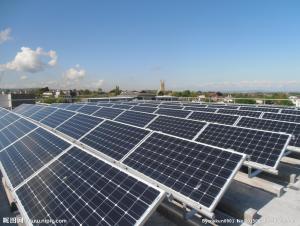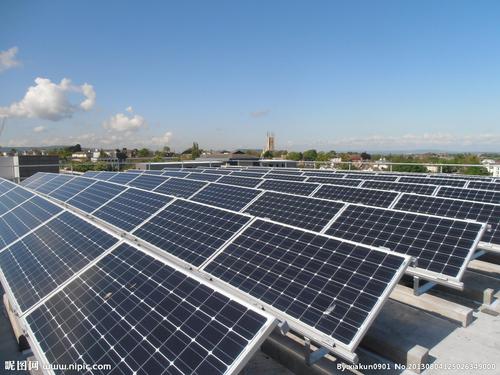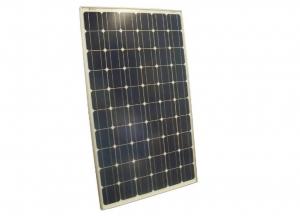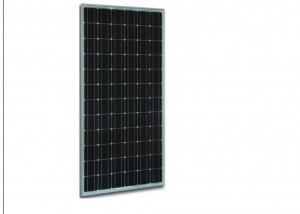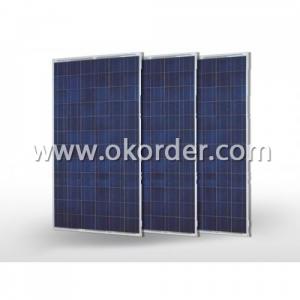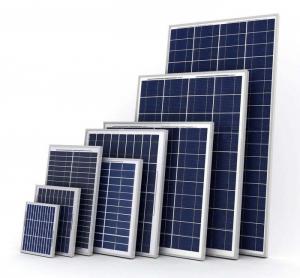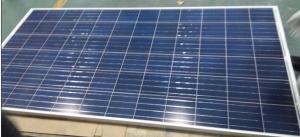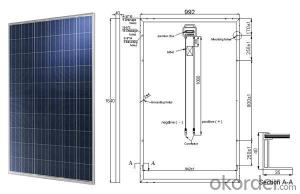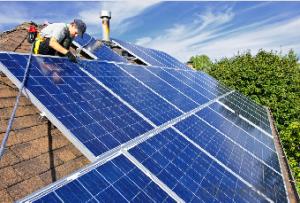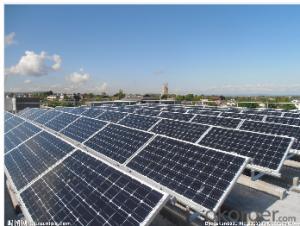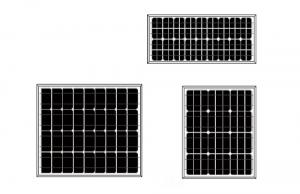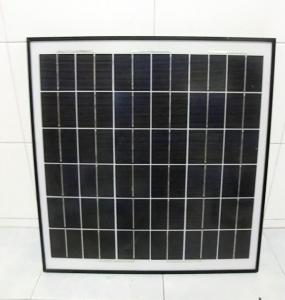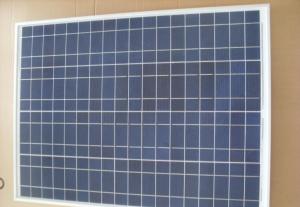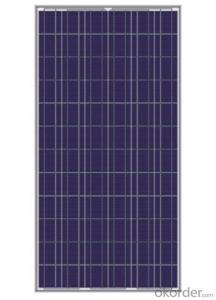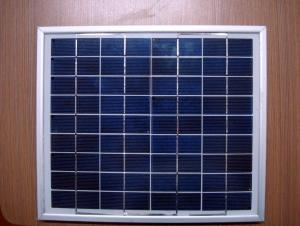Asp Solar Panels Solar Module6
- Loading Port:
- China Main Port
- Payment Terms:
- TT OR LC
- Min Order Qty:
- -
- Supply Capability:
- -
OKorder Service Pledge
OKorder Financial Service
You Might Also Like
Solar Module
ABOUT YINGLI GREEN ENERGY
Yingli Green Energy Holding Company Limited (NYSE: YGE) is one of
the world’s largest fully vertically integrated PV manufacturers, which
markets its products under the brand “Yingli Solar“. With over 7.0GW
of modules installed globally, we are a leading solar energy company
built upon proven product reliability and sustainable performance. We
are the fi rst renewable energy company and the fi rst Chinese company
to sponsor the FIFA World CupTM.
PERFORMANCE
- High effi ciency, multicrystalline silicon solar cells with high transmission
and textured glass deliver a module effi ciency of up to 16.0%,
minimizing installation costs and maximizing the kWh output of your
system per unit area.
- Tight positive power tolerance of 0W to +5W ensures you receive
modules at or above nameplate power and contributes to minimizing
module mismatch losses leading to improved system yield.
- Top ranking in the “TÜV Rheinland Energy Yield Test” and the
“PHOTON Test” demonstrates high performance and annual energy
production.
RELIABILITY
- Tests by independent laboratories prove that Yingli Solar modules:
Fully conform to certifi cation and regulatory standards.
Withstand wind loads of up to 2.4kPa and snow loads of up to
5.4kPa, confi rming mechanical stability.
Successfully endure ammonia and salt-mist exposure at the highest
severity level, ensuring their performance in adverse conditions.
- Manufacturing facility certifi ed by TÜV Rheinland to ISO 9001:2008,
ISO 14001:2004 and BS OHSAS 18001:2007.
WARRANTIES
- 10-year limited product warranty1.
- Limited power warranty1: 10 years at 91.2% of the minimal rated power
output, 25 years at 80.7% of the minimal rated power output.
1In compliance with our Warranty Terms and Conditions.
QUALIFICATIONS & CERTIFICATES
IEC 61215, IEC 61730, MCS, CE, ISO 9001:2008, ISO 14001:2004, BS OHSAS
18001:2007, PV Cycle, SA 8000
ELECTRICAL PERFORMANCE
Electrical parameters at Standard Test Conditions (STC)
Module type YLxxxP-29b (xxx=Pmax)
Power output Pmax W 260 255 250 245 240
Power output tolerances ΔPmax W 0 / + 5
Module effi ciency ηm % 16.0 15.7 15.4 15.1 14.8
Voltage at Pmax Vmpp V 30.3 30.0 29.8 29.6 29.3
Current at Pmax Impp A 8.59 8.49 8.39 8.28 8.18
Open-circuit voltage Voc V 37.7 37.7 37.6 37.5 37.5
Short-circuit current Isc A 9.09 9.01 8.92 8.83 8.75
Electrical parameters at Nominal Operating Cell Temperature (NOCT)
Power output Pmax W 189.7 186.0 182.4 178.7 175.1
Voltage at Pmax Vmpp V 27.6 27.4 27.2 27.0 26.8
Current at Pmax Impp A 6.87 6.79 6.71 6.62 6.54
Open-circuit voltage Voc V 34.8 34.8 34.7 34.6 34.6
Short-circuit current Isc A 7.35 7.28 7.21 7.14 7.07
STC: 1000W/m2 irradiance, 25°C cell temperature, AM1.5g spectrum according to EN 60904-3.
Average relative effi ciency reduction of 3.3% at 200W/m2 according to EN 60904-1.
NOCT: open-circuit module operation temperature at 800W/m2 irradiance, 20°C ambient temperature, 1m/s wind speed.
OPERATING CONDITIONS
Max. system voltage 1000VDC
Max. series fuse rating 15A
Limiting reverse current 15A
Operating temperature range -40°C to 85°C
Max. static load, front (e.g., snow) 5400Pa
Max. static load, back (e.g., wind) 2400Pa
Max. hailstone impact (diameter / velocity) 25mm / 23m/s
CONSTRUCTION MATERIALS
Front cover (material / thickness) low-iron tempered glass / 3.2mm
Cell (quantity / material / dimensions /
number of busbars)
60 / multicrystalline silicon / 156mm x 156mm / 2 or 3
Encapsulant (material) ethylene vinyl acetate (EVA)
Frame (material / color / anodization color /
edge sealing) anodized aluminum alloy / silver / clear / silicone or tape
Junction box (protection degree) ≥ IP65
Cable (length / cross-sectional area) 1000mm / 4mm2
Plug connector
(type / protection degree) MC4 / IP67 or YT08-1 / IP67 or Amphenol H4 / IP68
PACKAGING SPECIFICATIONS
Number of modules per pallet 29
Number of pallets per 40' container 28
Packaging box dimensions
(L / W / H) 1700mm / 1135mm / 1165mm
Box weight 568kg
Unit: mm
• Due to continuous innovation, research and product improvement, the specifi cations in this product information sheet are subject to change
without prior notice. The specifi cations may deviate slightly and are not guaranteed.
• The data do not refer to a single module and they are not part of the offer, they only serve for comparison to different module types
- Q: Can solar panels be used in combination with other renewable energy sources?
- Yes, solar panels can be used in combination with other renewable energy sources. This combination, often referred to as hybrid renewable systems, allows for a more reliable and efficient energy production. By integrating solar panels with other sources like wind turbines or hydroelectric power, a diversified energy mix can be created, maximizing the overall energy generation and reducing dependency on a single source.
- Q: How much electricity can a solar panel produce?
- The amount of electricity a solar panel can produce depends on various factors such as the size and efficiency of the panel, the amount of sunlight it receives, and the location. On average, a standard solar panel can produce anywhere between 250 to 400 watts of electricity per hour.
- Q: i was told that by making a solar panel they cause more pollution than they will end up getting rid of. Is that true?
- Absolutely not. This is a myth. The energy payback of a solar panel far outweighs its cost. With current technology (which is vastly improving every year), the payback begins in about -4 years depending on climate. This means that after -4 years, the solar panel has generated the same amount of energy that was used in its entire creation up until the point that it was installed. The panel will then continue to generate power for another 20-25 years at 90-98% capacity if properly maintained. The U.S. Department of Energy has conducted extensive studies on the subject and the results (which i'm quoting) can be viewed on their PV Faq page...
- Q: I have a solar panel 7.5V .25W 50mah, connect 2 in parallel to power a RC boat. The boat use to run on 6cell battery pack - 7.2V 800Mah.The dc motor requirement based on the provided battery pack, i assume would be 7.2V and rated at (7.2V * .8Amp) = 2.96 Watt.Would two of my solar panels run this DC motor ?are my calculations or understanding correct ?do lend a hand dear ''world''
- Wood? Steel tubing could be a lot lighter. Use the hardest narrowest tires you can find bicycle wheels and tires would work nicely and they can be had with really light disc breaks. As for a motor a golf cart motor is made to order. You can get an old electric golf cart and have almost all the parts you will need. Hell cover the roof of the cart with photo voltaic and have a ball. Note I stress weight savings as weight will cost you energy and with photos you won't have much to spare. You will need a battery pac of some sort lithium are a better choice than lead acid. there is a ton more to consider good luck with your project.
- Q: Can solar panels be installed on water bodies or reservoirs?
- Yes, solar panels can be installed on water bodies or reservoirs. This type of installation is known as floating solar or floating photovoltaic (PV) systems. By installing solar panels on water bodies, it maximizes the use of space and offers numerous benefits such as reducing water evaporation, increasing energy production due to the cooling effect of the water, and providing an opportunity to repurpose underutilized water surfaces for renewable energy generation.
- Q: How much energy can a solar panel produce?
- The amount of energy a solar panel can produce depends on various factors such as its size, efficiency, location, weather conditions, and orientation. On average, a standard residential solar panel can produce anywhere from 250 to 400 watts of power. However, with advancements in technology, larger solar panels or those used in commercial installations can generate several kilowatts or even megawatts of electricity.
- Q: How do solar panels affect the property's long-term financial viability?
- Solar panels can positively impact a property's long-term financial viability by reducing or eliminating monthly electricity bills, providing potential revenue through excess energy production, increasing property value, and potentially attracting tax incentives or subsidies.
- Q: Can solar panels be used for powering a concert venue or entertainment center?
- Yes, solar panels can be used to power a concert venue or entertainment center. Solar energy can be harnessed through panels and converted into electricity, which can then be used to power various aspects of the venue, such as lighting, sound systems, and equipment. By utilizing solar panels, these venues can reduce their carbon footprint and potentially save on energy costs in the long run.
- Q: How do solar panels affect insurance rates?
- Solar panels can generally have a positive impact on insurance rates. While the installation of solar panels may slightly increase the dwelling coverage, the potential savings on electricity bills and the added value to the property can often outweigh any additional costs. Additionally, some insurance companies offer specialized policies and discounts for homes with solar panels, making it a favorable choice for homeowners.
- Q: when building a solar panel should the diode be on the positive or negative sidelittle more detail i just built a solar panel and im running it to a grid tie converter should i put diodes in if i add another panel or are they only for battery systems?
- Bypass diodes would be in parallel with groups of solar cells in a panel. For example, if a module has 72 cells, maybe every 8 cells, there will be a bypass diode. A bypass diode does nothing except salvage some of the energy from the panel if some of the cells are shaded, and others are not. Or, if you have multiple panels in a series string, the bypass diodes allow the other panels in a string to continue to contribute energy when one panel is shaded. Unless you're forced to put the panel(s) where there will be shade during the day, the bypass diode does not matter. Commercial panels all include bypass diodes. Blocking diodes are generally NOT included on commercial panels. If you're going to a grid-tied inverter, you probably don't need one. There are stringent regulations on how panels must be grounded, and whichever side of the panel is grounded should not have a blocking diode. NEC regulations call for a continuous ground to earth. For example, if you have negative ground on your system, the blocking diodes, if any, should go on the positive terminal of the panel. By the way, if you're in the US or Canada, do understand that a home-built panel will not be legal to connect to a grid-tied system. And a grid-tied inverter that plugs into the wall will also be illegal. I'm only saying this because I don't want you to get hurt, or your house to burn down. Line power is nothing to be trifled with.
Send your message to us
Asp Solar Panels Solar Module6
- Loading Port:
- China Main Port
- Payment Terms:
- TT OR LC
- Min Order Qty:
- -
- Supply Capability:
- -
OKorder Service Pledge
OKorder Financial Service
Similar products
Hot products
Hot Searches
Related keywords
